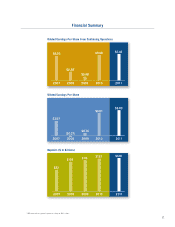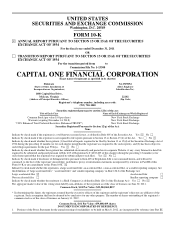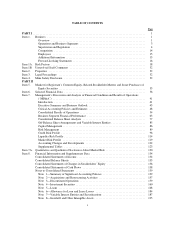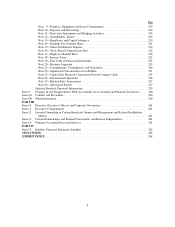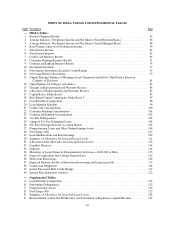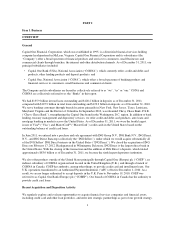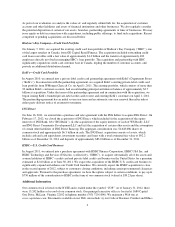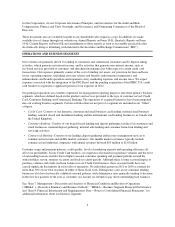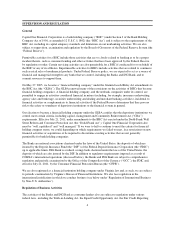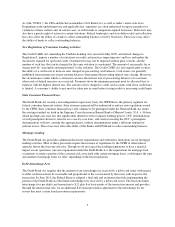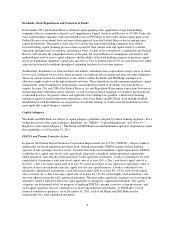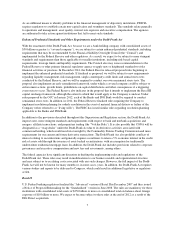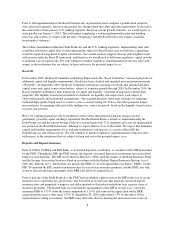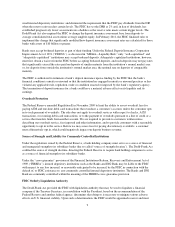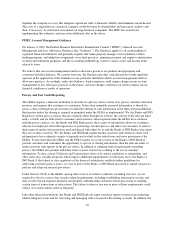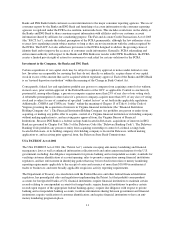Capital One 2011 Annual Report Download - page 23
Download and view the complete annual report
Please find page 23 of the 2011 Capital One annual report below. You can navigate through the pages in the report by either clicking on the pages listed below, or by using the keyword search tool below to find specific information within the annual report.
for the Corporation; (ii) our Corporate Governance Principles; and (iii) charters for the Audit and Risk,
Compensation, Finance and Trust Oversight, and Governance and Nominating Committees of the Board of
Directors.
These documents also are available in print to any shareholder who requests a copy. In addition, we make
available free of charge through our website our Annual Reports on Form 10-K, Quarterly Reports on Form
10-Q, Current Reports on Form 8-K and amendments to those reports as soon as reasonably practicable after
electronically filing or furnishing such material to the Securities and Exchange Commission (“SEC”).
OPERATIONS AND BUSINESS SEGMENTS
Our revenues are primarily driven by lending to consumers and commercial customers and by deposit-taking
activities, which generate net interest income, and by activities that generate non-interest income, such as
fee-based services provided to customers and merchant interchange fees with respect to certain credit card
transactions. Our expenses primarily consist of the cost of funding our assets, our provision for loan and lease
losses, operating expenses (including associate salaries and benefits, infrastructure maintenance and
enhancements and branch operations and expansion costs), marketing expenses and income taxes. We expect
expenses associated with the integration of the ING Direct and the pending acquisition of the HSBC U.S. credit
card business to represent a significant portion of our expenses in 2012.
Our principal operations are currently organized, for management reporting purposes, into three primary business
segments, which are defined based on the products and services provided or the type of customer served: Credit
Card, Consumer Banking and Commercial Banking. The operations of acquired businesses have been integrated
into our existing business segments. Certain activities that are not part of a segment are included in our “Other”
category.
•Credit Card: Consists of our domestic consumer and small business card lending, national small business
lending, national closed end installment lending and the international card lending businesses in Canada and
the United Kingdom.
•Consumer Banking: Consists of our branch-based lending and deposit gathering activities for consumers and
small businesses, national deposit gathering, national auto lending and consumer home loan lending and
servicing activities.
•Commercial Banking: Consists of our lending, deposit gathering and treasury management services to
commercial real estate and middle market customers. Our middle market customers typically include
commercial and industrial companies with annual revenues between $10 million to $1.0 billion.
Customer usage and payment patterns, credit quality, levels of marketing expense and operating efficiency all
affect our profitability. In our Credit Card business, we experience fluctuations in purchase volumes and the level
of outstanding loan receivables due to higher seasonal consumer spending and payment patterns around the
winter holiday season, summer vacations and back-to-school periods. Although there is some seasonal impact to
purchase volumes and credit card loan balances in our Credit Card business, these seasonal trends have not
caused significant fluctuations in our results of operations. No individual quarter in 2011 or 2010 accounted for
more than 30% of our total revenues in either of these fiscal years. Delinquency rates in our consumer lending
businesses also have historically exhibited seasonal patterns, with delinquency rates generally tending to decrease
in the first two quarters of the year as customers use income tax refunds to pay down outstanding loan balances.
See “Item 7. Management’s Discussion and Analysis of Financial Condition and Results of Operations
(“MD&A”)—Executive Summary and Business Outlook,” “MD&A—Business Segment Financial Performance”
and “Item 8. Financial Information and Supplementary Data—Notes to Consolidated Financial Statements” for
additional information about our business segments.
3


